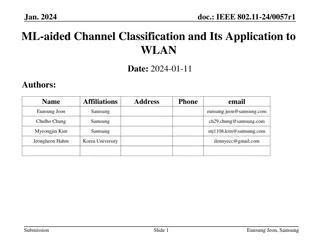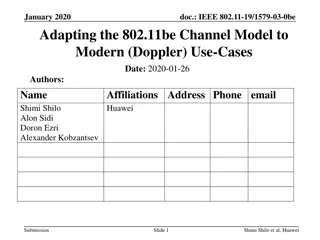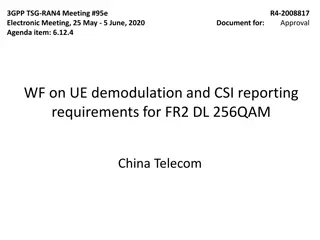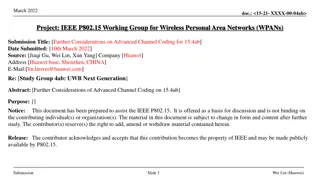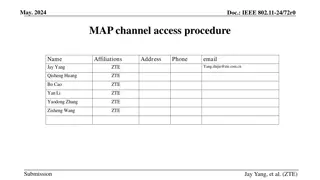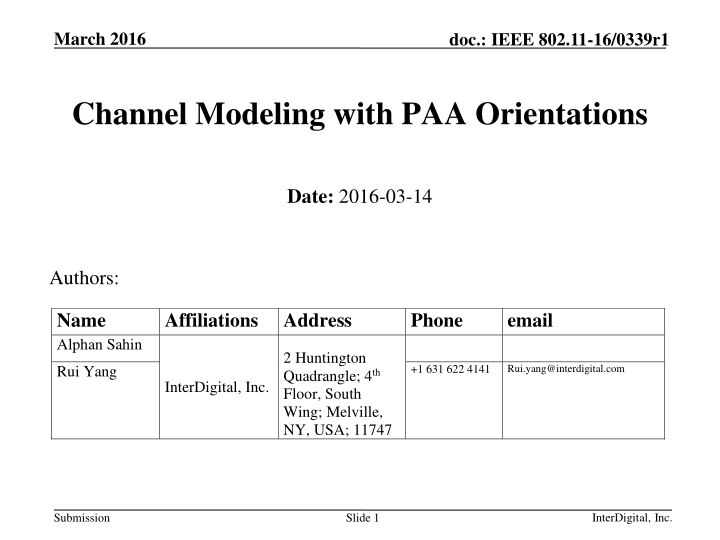
IEEE 802.11-16/0339r1 Channel Modeling with PAA Orientations
Explore the impact of polarized antenna orientations on channel capacity in IEEE 802.11-16/0339r1 document. The study proposes including orientation information in the channel model explicitly, shedding light on Jones vector characterization and antenna polarization types.
Download Presentation

Please find below an Image/Link to download the presentation.
The content on the website is provided AS IS for your information and personal use only. It may not be sold, licensed, or shared on other websites without obtaining consent from the author. If you encounter any issues during the download, it is possible that the publisher has removed the file from their server.
You are allowed to download the files provided on this website for personal or commercial use, subject to the condition that they are used lawfully. All files are the property of their respective owners.
The content on the website is provided AS IS for your information and personal use only. It may not be sold, licensed, or shared on other websites without obtaining consent from the author.
E N D
Presentation Transcript
March 2016 doc.: IEEE 802.11-16/0339r1 Channel Modeling with PAA Orientations Date: 2016-03-14 Authors: Name Alphan Sahin Affiliations Address 2 Huntington Quadrangle; 4th Floor, South Wing; Melville, NY, USA; 11747 Phone +1 631 622 4141 email Rui.yang@interdigital.com Rui Yang InterDigital, Inc. InterDigital, Inc. Submission Slide 1
March 2016 doc.: IEEE 802.11-16/0339r1 Abstract In this study, we use an example to demonstrate the impact of polarized antenna orientation on the channel capacity for different PAA configurations. We propose to include orientation information of the antennas in the channel model explicitly InterDigital, Inc. Submission Slide 2
March 2016 doc.: IEEE 802.11-16/0339r1 Background: Polarization 802.11ay channel model [1] adopts the polarization model of 802.11ad [2]. ( = 0 i z ) k 1 N ( ) E rays ( ) t ( ) ( ) ( ) i H H = ch i ch i h e H e U V t t RX TX pol i E r Gain coefficients between the orthogonal electric components. Jones vectors at the transmitter side. Jones vectors at the receiver side. y Antenna polarization type Linear polarized in the -direction Linear polarized in the -direction Corresponding Jones vector 1 0T 0 1T 1 1 ?T x The orthogonal components of Jones vector are defined for E and E components respectively [2]. Left hand circular polarized (LHCP) 2 1 1 ?T Right hand circular polarized (RHCP) 2 InterDigital, Inc. Submission Slide 3
March 2016 doc.: IEEE 802.11-16/0339r1 Problem The Jones vector characterizes the electric field, which is perpendicular to a given wave propagation direction (k). The values of the Jones vector elements depend on the selection of reference coordinate system (xyz) from which the azimuth ? and elevation ? angles are determined, given a wavevector direction. These angles may be different at Tx and Rx sides, respectively. In the current channel model, it is not clear Which reference coordinate systems are used for Tx and Rx Jones vectors; and If the ?? matrix captures the relative orientation of the transmitter and receiver antennas. InterDigital, Inc. Submission Slide 4
March 2016 doc.: IEEE 802.11-16/0339r1 Some Examples: Assumptions Configuration #2 (2x2 MIMO) Configuration #3 (2x2 MIMO) Configuration #4 (4x4 MIMO) Distance between array centers - d PAA element Phase shifterV pol Distance between array centers - d Each element has dual polarization Signal 3rd stream V and H pol Signal 2nd stream PAA element E Signal 4th stream Phase shifter H pol Phase shifterV pol PAA element Signal 1st stream PAA element Signal 1st stream Signal 2nd stream PAA #2 PAA #2 Phase shifter V pol H pol H pol Phase shifterV pol or PAA #1 Signal 1st stream PAA #1 E E PAA element H and V pol V pol H pol Signal 2nd stream H and V pol or E E H pol We consider the same deployment scenario (single ray LOS) as that given in reference [3,4] with the following parameters: Both TX PAA and RX PAAs have the same geometry of 2 8 elements (?? = ?? = ?/2). Distance between the geometrical centers of TX/RX PAAs: ? = 10 cm. Distance between TX and RX devices is 300 cm. It is assumed that TX PAA 1 beamforms with RX PAA 1 and TX PAA 2 beamforms with RX PAA 2 for Configuration #3 and Configuration #4. The bandwidth is 2.640 GHz. The output power of each TX PAA is 10 dBm. The noise figure is 10 dB [3]. InterDigital, Inc. Submission Slide 5
March 2016 doc.: IEEE 802.11-16/0339r1 Some Examples: Capacity Results Consider the CIR of LoS with ?(?)= ?, and a 2D rotation matrix ? ? ????? = ??? where ? is relative orientation between Tx and Rx antennas, ??? and ??? are the Jones vectors represented in the coordinate systems (xyz) attached to each Tx and Rx PAA ?? ? ????? ?? ? V x Rotation ? z y H Link capacity depends on the relative orientation of Tx and Rx antennas and polarization of each PAA. InterDigital, Inc. Submission Slide 6
March 2016 doc.: IEEE 802.11-16/0339r1 Discussion (1/2) In general, given a ray direction, the Jones vector can be represented in any coordinate system. In practice, it is convenient to represent it in a local coordinate system that is attached to Tx [Rx] antenna. Then, the Jones vector is the function of azimuth ? and elevation angles (??,??), [(??,??)]. Since the local coordinate system of Tx and Rx are most likely different, it will be more convenient to map them to a common (global) coordinate system. This step can be achieved using Euler rotations, which may be represented by Euler angles t, ?, t [ r, ?, r]. InterDigital, Inc. Submission Slide 7
March 2016 doc.: IEEE 802.11-16/0339r1 Discussion (2/2) With the above considerations, the CIR of channel model with polarized antennas may be expressed as ???? 1 ? ?? ? ? ? ??(? ??) ? ? ??? ? ?? ??? ? ????? = ?? ?? ?=0 where cos ? sin ? sin ? cos ? ?,?? ?,?? ? ? = ?is a function of r, ?, r,?? ?is a function of t, ?, t,?? ?, ? ? ?? is a 2x2 matrix which capture the impact of reflectors and cross-polarization coupling [2] Slide 8 ? InterDigital, Inc. Submission
March 2016 doc.: IEEE 802.11-16/0339r1 Conclusion We demonstrate the impact of antenna orientation on channel capacity for different antenna configurations. We propose a mechanism to include antenna orientation in the polarization component of the channel model. InterDigital, Inc. Submission Slide 9
March 2016 doc.: IEEE 802.11-16/0339r1 References 1. A. Maltsev, et al, Channel models for IEEE 802.11ay, IEEE doc. 11- 15/1150r1. A. Maltsev, et al, Channel Models for 60 GHz WLAN Systems, IEEE doc. 11-09/0334r8. A. Maltsev, et al, Experimental Measurements for Short Range LOS SU- MIMO, IEEE doc. 11-15/0632r1. R. Yang and A. Sahin, Feasibility of SU-MIMO under Array Alignment Method, IEEE Doc. 11-15/1333r1 2. 3. 4. InterDigital, Inc. Submission Slide 10
March 2016 doc.: IEEE 802.11-16/0339r1 Appendix: Example of Euler Rotations ? ? ? ? ? ? ? ? ? ? ? ? ? ? ? ? cos sin 0 sin cos 0 0 0 1 1 0 0 0 0 cos sin 0 sin cos 0 0 0 1 ?1 = cos sin sin cos ?2 = ?1 = ? = ?1 ?2 ?( ) InterDigital, Inc. Submission Slide 11




